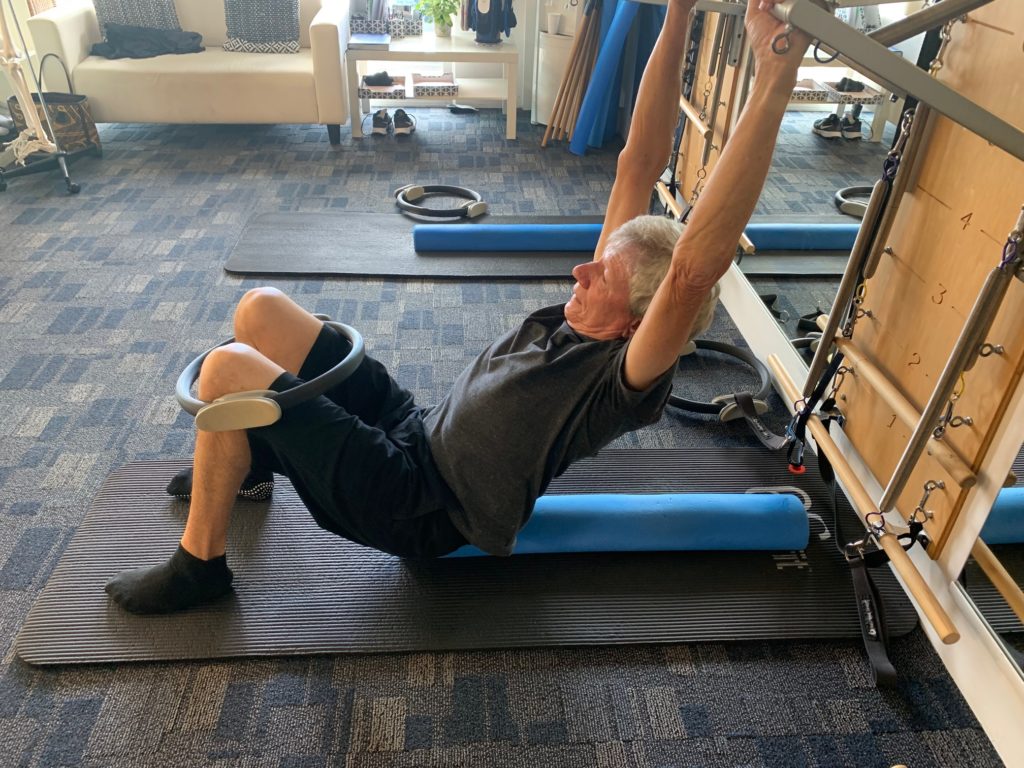
Strokes are a major health problem in our society and patients undergo health and fitness challenges that lead each person to change their lifestyle to assist with their rehabilitation.
Modified and specific Pilates exercises assist with significant changes in obtaining more movement in the affected side with increased mobility, balance, core strength. This in turn promotes self esteem and an increased ability to perform daily activities.
PAA Committee Member Andree Lupton shares her experience of using Pilates with a client recovering from a stroke and gives us an insight into the journey.
Robin’s Stroke Journey
Robin’s stroke happened at home in July 2014. His initial rehabilitation was advised as hospital based physio and occupational therapy until he was assessed as being unable to improve further and was discharged from hospital. Then he was on the merry go round of finding the right exercise therapist to further assist him. He was given a care plan from the doctor and tried working with many different Allied Health professionals however was not satisfied with his treatment so far.
This led Robin to seek out further therapy-based exercise as he was determined to improve his movements. His wife, who attends a professional Pilates studio twice a week suggested he have a private consultation and hence he arrived with us at Newlife Studio Pilates, Dunsborough WA.
When Robin attended his first session we first had to teach him about pelvic clockwork and how to connect his distal to proximal points in his body. We started with this teaching so we could get the spine to start moving with pelvic flexion and extension and incorporate the movements of the ribcage with the clockwork, then going around the clock face moving the pelvis like hula hooping 10 times each way. This led to an easier transition into pelvic curls as clockwork teaches you the technique while moving up to 12 o’clock and then back down to 6 o’clock. We then had to get his glutes to fire in the pelvic curl, so we placed a ball (and transitioned to magic circle) between his knees to assist with more connection of glutes and hamstrings.
Robin’s leg and footwork was performed against a jumpboard as this was easier for him to feel the closed chain movement. We also used foot savers to wake up the feet using the trigger points on the fascial line of the bottom of the foot, as his left side was the affected side in his stroke. We continually worked with single leg work to teach him how to use the hamstrings and the core to connect to the feet (proximal and distal points).

For all his upper body work we laid him on a half flat roller with a magic circle on top of the knees so his abductors got some work. He learnt to use his shoulder blades by wrapping them around the flat roller and holding on to the push through bar on the cadillac bed, keeping his arms long. At this stage he could only connect the thumb and index finger on the left side, so we did the same on the right and continued with improvement until he could feel his fingers. We mainly did shoulder blade exercises to teach proximal (shoulder blade) to distal (hand) points and with the use of hand weights with supine arm work using the shoulder blades.
The biggest challenge for Robin was strengthening the base of his body (glutes and abdominals) and learning how to connect them together for his balance. He said he didn’t have a bum, but we found it! Then he realised how important the base was in his body – a strong base is most important for our spine.

Robin can now manage to complete a whole class from the beginning to end quite well but needs to slow down and learn to breathe. We have also included hand exercises with the Makarlu domes which help his fingers to function better when they become claw like – a side affect of his stroke. He has seen a marked improvement after his first session teaching the proximal to distal connection with shoulder blades and palms. We have discovered a huge improvement in that his fingers become looser and he has smoother gait when walking in daily activities. Quite remarkable!!
Inspired by a book he’d read called Spark: The Revolutionary New Science of Exercise and the Brain by Dr. John Ratey, Robin found his first Pilates session was an eye opener. A great mix for his non obedient body and state of health, and perfect as a mind and body therapy which was low key fun with instantly improved self esteem.
Pilates has continued to help Robin build strength and confidence and the ability to pass his driving test. This has inspired the confidence to drive himself to and from appointments giving him his independence back again.
His confidence and self esteem building encouraged Robin to join a local croquet club and compete. The game is full of sequential mind and body games and he notes that after years of Pilates his strength and balance have improved so much it allows him to play and compete at a good level (some thought, too good)!!!
Robin is so enthusiastic, turning up 15 mins early to stretch and prepare for his session and highly recommends Pilates as ideal recovery therapy for stroke. His continuous improvement through the professional Pilates Method allows him to manage a normal lifestyle as life goes on 7 years later -however small, these are very important steps for his daily living!!!
Robin says it would take a book to explain how much professional Pilates has changed his life and he’s very grateful for all the support, patience and humour he’s experienced and most importantly for the large support group he has created with all the other clients.
Andree Lupton
PAA Committee member

Comments are closed.